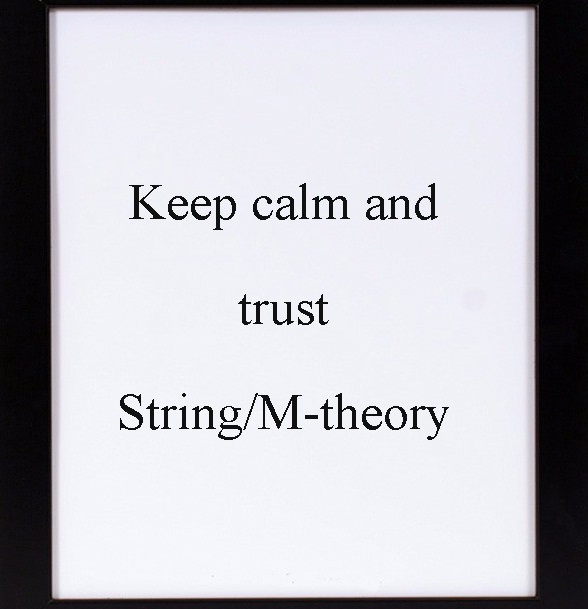This is how the worldsheet quantum theory knows all about spacetime physics. Setting the stage first. Since branes are ‘generalizations’, and are BPS, the supergravity solution in the multi-brane harmonic function form is:
![Rendered by QuickLaTeX.com \[H_p^{{\rm{array}}} = 1 + \sum\limits_{n = - \infty }^{ + \infty } {\frac{{r_p^{7 - p}}}{{{{\left| {{{\widetilde r}^2} + {{\left( {{X^{p + 1}} - 2\pi nR} \right)}^2}} \right|}^{(7 - p)/2}}}}} \]](https://www.georgeshiber.com/wp-content/ql-cache/quicklatex.com-97b7a086ca2f551db40bd45241bad45d_l3.png)
with:
![]()
Thus, I can now derive:
![Rendered by QuickLaTeX.com \[H_p^{{\rm{array}}} \sim 1 + \frac{{r_p^{7 - p}}}{{2\pi R}}\frac{1}{{{{\widetilde r}^{6 - p}}}}\int\limits_{ - \infty }^\infty {\frac{{du}}{{{{\left( {1 + {u^2}} \right)}^{\left( {7 - p} \right)/2}}}}} \]](https://www.georgeshiber.com/wp-content/ql-cache/quicklatex.com-ce93ca1534d3bc94a65d55bd6059eecd_l3.png)
Hence, the integral is:
![Rendered by QuickLaTeX.com \[\int\limits_{n = - \infty }^{ + \infty } {\frac{{du}}{{{{\left( {1 + {u^2}} \right)}^{\left( {7 - {p^n}} \right)/2}}}}} = \frac{{\sqrt {2\pi n{R^n}} {\mkern 1mu} \Gamma \left[ {\frac{1}{2}\left( {6 - {p^n}} \right)} \right]}}{{\Gamma \left[ {\frac{1}{2}\left( {7 - {p^n}} \right)} \right]}}\]](https://www.georgeshiber.com/wp-content/ql-cache/quicklatex.com-6378aecc3a4468ee46e13d8249c04c08_l3.png)
After checking renormalization, one gets:
![]()
which is the correct harmonic function for a D(p+1)-brane. The relevance of ![]() is that via Green’s functional analysis, it yields the string coupling of the dual 25-D theory:
is that via Green’s functional analysis, it yields the string coupling of the dual 25-D theory:
![]()
which is key to the T-duality transformation properties of propagating background matter fields in 4-dimensional space-time, with ![]() the bosonic field configuration corresponding to the string world-sheet, whose variable is
the bosonic field configuration corresponding to the string world-sheet, whose variable is ![]() , yielding the two following key relations:
, yielding the two following key relations:
![Rendered by QuickLaTeX.com \[\begin{array}{c}({T_p}\left( {2\pi \sqrt {\alpha '} } \right){e^{ - {\Phi _{bos}}}}\prod\limits_{i = 1}^{p - 1} {\left( {2\pi {R_p}} \right)} = \\{T_{p - 1}}{e^{ - \Phi _{bos}^{1/2}}}\prod\limits_{i = 1}^{p - 1} {\left( {2\pi {R_{p - 1}}} \right)} \end{array}\]](https://www.georgeshiber.com/wp-content/ql-cache/quicklatex.com-8810308c79381bf0f22ba417dce0c20b_l3.png)
and
![Rendered by QuickLaTeX.com \[\frac{d}{{{d_{{\sigma _p}}}}}\int\limits_{{\rm{worldvolumes}}}^p {{e^{H_{p + 1}^{{\rm{array}}}}}} + \underbrace {\sum\limits_{{\sigma _p}}^D {{{\left( {S_p^D} \right)}^{ - H_{p + 1}^{{\rm{array}}}}}} }_{{\rm{topologies}}}\]](https://www.georgeshiber.com/wp-content/ql-cache/quicklatex.com-eac6615751f3de7e728719e91821ec83_l3.png)
and so, one can use a Lagrange multiplier to derive the action:
![Rendered by QuickLaTeX.com \[\begin{array}{c}{S_\sigma } = \frac{1}{{4\pi \alpha '}} + \int\limits_{{\rm{endpoints}}} {{d^2}} \sigma {g^{1/2}}\left\{ {{g^{ab}}d\,\Omega {{\left( {{\phi _{INST}}} \right)}^2}\left[ {{G_{25,25,{v_a}{v_b}}} + 2{G_{25,\mu }}{v_a}{{\not \partial }_b}{X^\mu } + {G_{\mu \nu }}{{\not \partial }_a}{X^\nu }} \right]} \right\} + \\\frac{1}{{{{\left( {4\pi \alpha '} \right)}^2}}}\int\limits_{{\rm{worldsheets}}} {i{\varepsilon ^{ab}}} \left[ {2{B_{25,\mu }}{v_a}{{\not \partial }_b}{X^\mu } + {B_{\mu \nu }}{{\not \partial }_a}{X^\mu }{{\not \partial }_b}{X^\nu }d\,\Omega {{\left( {{\phi _{INST}}} \right)}^{ - 2}} + 2{{X'}_{25}}\,{{\not \partial }_{a,{v_b}}}} \right] + \\\frac{1}{{{{\left( {4\pi \alpha '} \right)}^3}}}\int\limits_{{\rm{worldvolumes}}} {i{\varepsilon ^{ab}}} \not D_\mu ^{susy}{\phi _{si}}\left( {\exp \left( {{e^{{\Phi _{bos}}}}\frac{{{{\alpha '}^{1/2}}}}{R}} \right)} \right) + \not D_\nu ^{susy}\widetilde {{\phi _{si}}}\left( {\exp \left( {{e^{{{\widetilde \Phi }_{bos}}}}\frac{{{{\alpha '}^{1/2}}}}{R}} \right)} \right)\end{array}\]](https://www.georgeshiber.com/wp-content/ql-cache/quicklatex.com-11360dc00dbfb5e56a4f9eb3030a3861_l3.png)
since the Lagrange multiplier equation of motion has solution:
![]()
given that its Clifford form is:
![]()
for ![]() any scalar. So, for
any scalar. So, for ![]() :
:
![Rendered by QuickLaTeX.com \[\frac{{\not D_\mu ^{susy}L}}{{{{\not \partial }_{{v_a}}}}} - {\mkern 1mu} \frac{\partial }{{{{\not \partial }_{{\sigma _b}}}}}\left( {\frac{{\not D_\nu ^{susy}L}}{{\not \partial \left( {{{\not \partial }_{b,{v_a}}}} \right)}}} \right) = 0 = {g^{ab}}\left[ {{G_{25,25,{v_a}}} + {G_{25,\mu }}{X^\mu }} \right] + i{\varepsilon ^{ab}}\left[ {{B_{25,\mu }}\not \partial {X^\mu } + {{\not \partial }_b}{X^{25}}} \right]\]](https://www.georgeshiber.com/wp-content/ql-cache/quicklatex.com-e8dd897e5d8e3e36f5e6e5843469fcc9_l3.png)
Now, by solving via a ![]() metric:
metric:
![]()
we get the Dp action:
![Rendered by QuickLaTeX.com \[S_p^D = \, - {T_p}\int\limits_{{\rm{worldvolumes}}} {{d^{p + 1}}} \xi \frac{{\not D_{\mu \nu }^{susy}L}}{{{{\not \partial }_{{v_a}}}}}{e^{ - {\Phi _{bos}}}}{\rm{de}}{{\rm{t}}^{1/2}}G_{ab}^{\exp \left( {H_{p + 1}^{{\rm{array}}}} \right)}\]](https://www.georgeshiber.com/wp-content/ql-cache/quicklatex.com-3ee868f0f83c3f66855aa2539b9a4822_l3.png)
Since in 4-dimensional space-time, the mass of a Dp-brane can be derived as:
![Rendered by QuickLaTeX.com \[{T_p}{e^{ - {\Phi _{bos}}}}\prod\limits_{i = 1}^p {\left( {2\pi nR} \right)} \]](https://www.georgeshiber.com/wp-content/ql-cache/quicklatex.com-3c2f43a024963feed958e11d0d7d3fbf_l3.png)
by T-dualizing in the
![]()
direction and factoring the dilaton, the dual is hence:
![Rendered by QuickLaTeX.com \[\begin{array}{c}({T_p}\left( {2\pi \sqrt {\alpha '} } \right){e^{ - {\Phi _{bos}}}}\prod\limits_{i = 1}^{p - 1} {\left( {2\pi {R_p}} \right)} = \\{T_{p - 1}}{e^{ - \Phi _{bos}^{1/2}}}\prod\limits_{i = 1}^{p - 1} {\left( {2\pi {R_{p - 1}}} \right)} \end{array}\]](https://www.georgeshiber.com/wp-content/ql-cache/quicklatex.com-8810308c79381bf0f22ba417dce0c20b_l3.png)
By matrix world-volume integral reduction on
![Rendered by QuickLaTeX.com \[S_p^D = \, - {T_p}\int\limits_{{\rm{worldvolumes}}} {{d^{p + 1}}} \xi \frac{{\not D_{\mu \nu }^{susy}L}}{{{{\not \partial }_{{v_a}}}}}{e^{ - {\Phi _{bos}}}}{\rm{de}}{{\rm{t}}^{1/2}}G_{ab}^{\exp \left( {H_{p + 1}^{{\rm{array}}}} \right)}\]](https://www.georgeshiber.com/wp-content/ql-cache/quicklatex.com-3ee868f0f83c3f66855aa2539b9a4822_l3.png)
the Polyakov action for the string is hence:
![]()
with ![]() the embedding of the string in target space,
the embedding of the string in target space, ![]() the worldsheet metric, and
the worldsheet metric, and ![]() the spacetime metric. The renormalization Lie-equation for the sigma-model on the string worldsheet entails that
the spacetime metric. The renormalization Lie-equation for the sigma-model on the string worldsheet entails that
![]()
So, from
![Rendered by QuickLaTeX.com \[\begin{array}{c}({T_p}\left( {2\pi \sqrt {\alpha '} } \right){e^{ - {\Phi _{bos}}}}\prod\limits_{i = 1}^{p - 1} {\left( {2\pi {R_p}} \right)} = \\{T_{p - 1}}{e^{ - \Phi _{bos}^{1/2}}}\prod\limits_{i = 1}^{p - 1} {\left( {2\pi {R_{p - 1}}} \right)} \end{array}\]](https://www.georgeshiber.com/wp-content/ql-cache/quicklatex.com-8810308c79381bf0f22ba417dce0c20b_l3.png)
the Einstein vacuum field equation is encoded in the quantum structure of the conformal worldsheet theory as characterized by
![]()
Therefore, the β-function equation gives a definition of the stress-energy tensor for the worldsheet theory
![]()
with
![]()
By holographic renormalization, it follows that the worldsheet quantum theory knows all about spacetime physics
as attested by
![Rendered by QuickLaTeX.com \[\frac{d}{{{d_{{\sigma _p}}}}}\int\limits_{{\rm{worldvolumes}}}^p {{e^{H_{p + 1}^{{\rm{array}}}}}} + \underbrace {\sum\limits_{{\sigma _p}}^D {{{\left( {S_p^D} \right)}^{ - H_{p + 1}^{{\rm{array}}}}}} }_{{\rm{topologies}}}\]](https://www.georgeshiber.com/wp-content/ql-cache/quicklatex.com-eac6615751f3de7e728719e91821ec83_l3.png)



1 Response
A Critical Analysis of Loop Quantum Gravity: Part 1, the Holst Action
Thursday, October 6, 2016[…] really) and LQG, let us contrast the actions. Realize, and this is key, that, unlike in LQG, as I showed, the worldsheet quantum theory of string-theory 'knows' all about 4-D spacetime physics […]